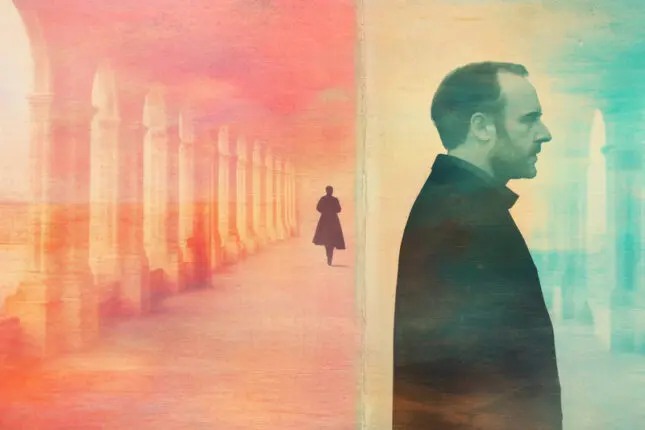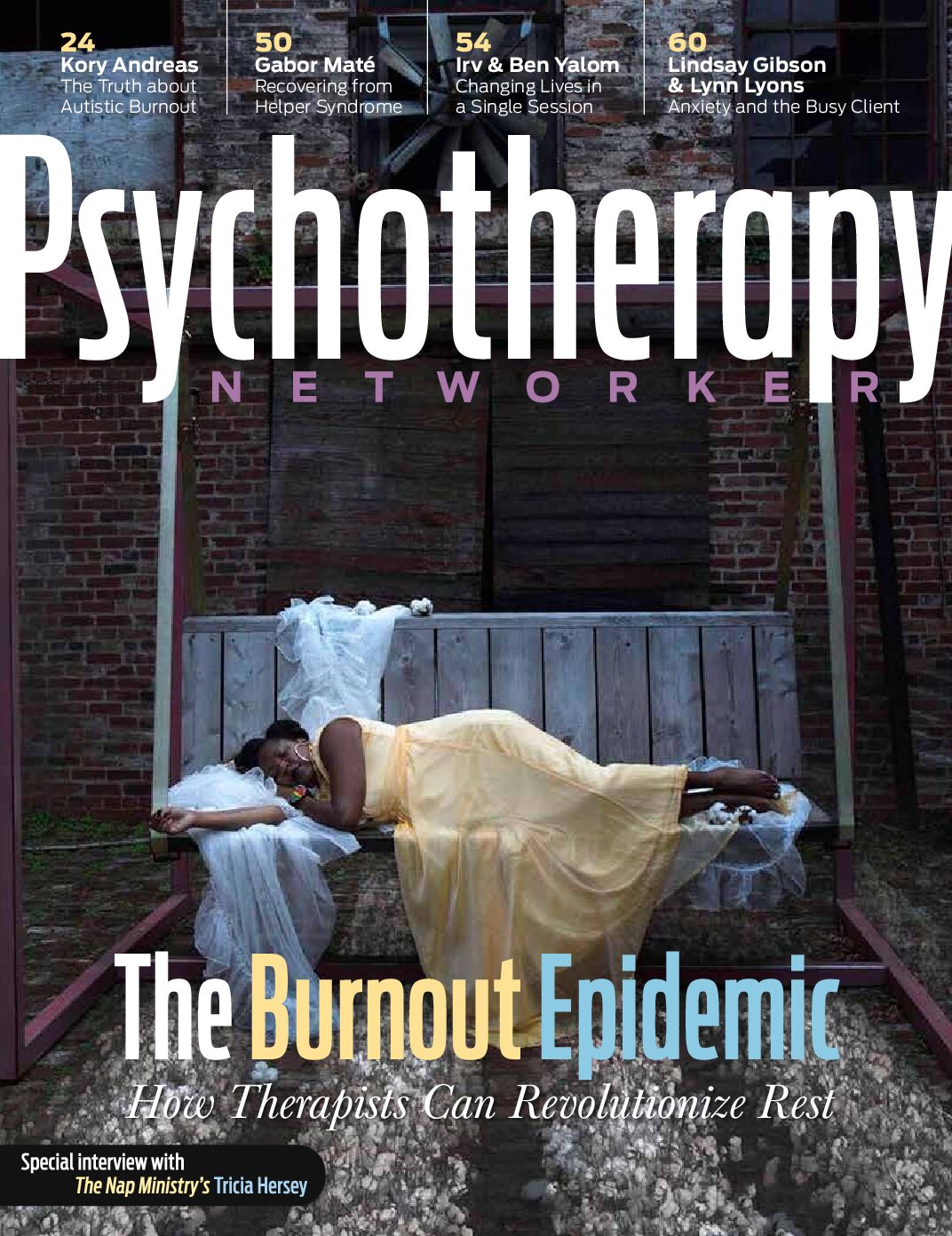Enjoy the audio version of this article—perfect for listening on the go.
“Here’s what happens when we first start working with couples,” declares George Faller, a certified Emotionally Focused Therapy (EFT) trainer and the presenter of the high-conflict couples workshop I’m attending at the 2025 Psychotherapy Networker Symposium. Faller looks comfortable on stage. He’s unphased by the ungainly speech-to-text microphone clipped to his flannel shirt, and it’s clear from the way he holds the clicker that he’s a PowerPoint pro. He raises his hand, and a slide featuring two pictures of Nicolas Cage appears. In the first, the actor grins under dark aviator sunglasses as only Nicolas Cage can, equal parts cool and goofy above the words Of course I can do this!
“But pretty soon the couples we see change our minds,” Faller says with ominous humor, using the laser pointer to circumnavigate the second Cage picture. In this one, Cage’s hair is a mess, his face and chest are caked with dirt and blood, and he’s squinting maniacally above the caption Three months later.
From the tenor and intensity of the laughter rippling through the room, it’s clear a lot of my fellow couples therapists can identify with that dramatic progression. It’s nice to know I’m not alone in this experience, and its particularly comforting to recognize the faces of well-known, acclaimed clinicians in the audience nodding along with the rest of us, including Ellyn Bader, co-founder of The Couples Institute, and in the third row, the woman many consider the queen of couples therapy: Esther Perel herself.
“We need to be ready for things to go wrong with couples,” Faller says. “I think we’re always hoping for empathy to emerge, so we don’t plan for the moments in session when it doesn’t—when partners go into a fight or flight response, when they interrupt each other, protest, and shut down.”
Despite the number of people in this huge workshop, it still feels oddly intimate, like I’m hanging out with a few colleagues and an off-duty New York City fireman. This is probably because Faller speaks off the cuff, as though we’re all trusted friends, here—but also because he himself is a former New York City fireman. Putting out literal fires and running into non-metaphorically burning buildings appears to have shaped his penchant for action-packed acronyms for couples therapy interventions like CPR, TARGET, TEMPO, and TERROR, but what really captures my attention is his take on a couples dynamic older than Antony and Cleopatra. It’s a pairing everyone’s heard about in relationships—as ubiquitous as hot-cold, love-hate, and introvert-extravert. In both pop culture and marriage and family therapy circles, it’s referenced so often that I, for one, have stopped paying attention to it.
Until now.
The Pursuer-Withdrawer Dynamic
Faller tells us a story about a young couple. They’ve been working too much. The wife takes out her phone one morning and sends her husband a text. “Hey, just thinking about you. Really hoping we get a chance to talk tonight. I feel like we’re disconnected.” When he sees her text, her husband thinks, She’s probably right. But he’s at work and doesn’t want to get into it now. He sends a quick smiley face emoji.
Are you kidding me? she thinks. I’m pouring out my heart, and I get an emoji? She follows up with another text. “We have to prioritize our connection. It’s the oxygen of the relationship. Why is it my burden to educate you on this? It would be nice if you initiated these conversations. You’re setting a bad example for our kids.” Her text goes on and on. He doesn’t know how to reply in the moment, so he does what withdrawers do well: he compartmentalizes what’s happening and gets back to work.
She waits. Nothing. Every time she looks at the phone, she feels rejected. I can’t believe he’s not responding, she thinks. He doesn’t care. I’m doing all the emotional labor here. Finally, she can’t take it anymore and calls him. Why not deal with the problem now? she’s convinced herself. Why wait until later?
He’s eating lunch and checking sports scores when the phone rings and her name pops up on the display screen. He silences the phone and doesn’t answer. We’re going to fight when I get home, he thinks. Why fight now and later?
Her call goes to voicemail. What kind of jerk did I marry? she asks herself. This is unacceptable. How did we reach this point of such disconnection? I can’t allow it. She gets in her car. When she arrives at his office, his secretary gives him a two-minute warning. “Your partner is here, and she seems upset.”
He goes to the bathroom, locks himself in a stall, and tries to think clearly. What am I going to do? The only solution he can come up with is to drop his phone in the toilet so when she asks why he didn’t pick up, he’ll have an excuse.
“Pursuers and withdrawers live in completely different realities.” Faller says.
The slide on the screen changes to a cartoon of someone on a desert island looking up at the sky and waving their hands. A bunch of stones at the person’s feet have been arranged into the letters SOS, and a fire by a palm tree sends up smoke signals. “Help!” Faller shrieks as he channels the pursuer’s despair. “They’re building fires, sending smoke signals, making SOS signs. Their body’s mobilizing. They’re trying to engage and get the connection they need. That’s what’s happening for the woman in that couple as she’s shooting off texts, calling, and eventually driving to confront her partner.”
Faller then brings up a different cartoon of a bearded man leaning against a palm tree on a similar island. He seems to be enjoying the ocean breeze as he watches a TV half-buried in the sand. “Separation for a pursuer is agony, but for a withdrawer, it’s a break. They can exhale. So why do you all think withdrawers shut down, walk away, and put up walls? Come on, you’re all therapists here! Shout out your answers!”
“Protection!” two people yell simultaneously.
“To defend themselves!” a voice calls from the back of the room.
“They’re in survival mode!” a therapist near me says.
“Fear of vulnerability!” someone else cries out.
“Yes! Keep it coming. I love it!” Faller nods, tracking each response. “All these words and phrases around defenses and survival.” As the audience settles, though, he says something I’m pretty sure none of us is expecting to hear. “And yet what everyone here is saying also shows therapists’ bias against withdrawers.”
Inside the Withdrawer’s Circle of Hell
“Close your eyes.” Faller is about to take us on a journey, and I’m not sure I want to go. I peek at the red-haired therapist sitting next to me. Comfortably settled into her fold-out chair, she’s already allowed her eyelids to lower. I lower mine, too. Faller, the stage, the screen, and the ballroom disappear into darkness. Like Dante, he’s leading us into a place many therapists in this room probably aren’t familiar with, given that we’re largely a group of pursuers (Gottman’s Love Lab research suggests women tend to pursue and 75% of therapists are women). We’re descending, little by little, into the withdrawer’s unique, internal hell.
“As a withdrawer, all you want to hear is ‘good job,’” he says quietly. “All you want is to be appreciated. Your heart wants to smile. Nothing more. This is why you’re in therapy. This is why you’re trying, even though you know you’re probably doomed to fail.”
I flash on the faces of withdrawers I’ve worked with—and some I’m still working with. I let myself feel them in a different way, with a little less impatience and a little more humility. It’s true—they’re doing their best. They’re trying to figure out what their partners want and how to provide it. They long to be appreciated for their efforts.
“But guess what?” Faller continues. My body braces instinctively for the impact of whatever he’s about to say next. “You don’t get the ‘good job’ you need. In fact, you never get it. Instead, you hear you’ve failed—again—and the reason you’ve failed is because you don’t care. You hear the opposite of what’s true for you, and you even hear it from your therapist when they confront you about withholding feelings or not “showing up,” or fail to challenge your partner’s complaints about the walls you’ve erected.”
The face of one of my pursuer clients appears in my mind’s eye. I see her mouth moving. I hear the angry words she’s directing at her partner. Despite being a large man, he seems to be shrinking into the cushions of my couch. She tells him he doesn’t care about their relationship, because if he did, he’d try harder. He’d give her the emotional closeness she’s been begging him for. How hard can that be?
“As a withdrawer, a part of you believes that what you’re being accused of is true,” Faller says. “You’ve heard this message so many times before. You’ve heard it as a kid, and in a lot of other relationships. You’ve heard you’re not smart enough, strong enough, thoughtful enough, good enough. You’ve heard, ‘You’re a failure.’ You’ve heard over and over how much other people don’t like you; and in this place, you don’t like you, either.”
I can sense how this version of not liking oneself—the withdrawer’s version—has a different emotional flavor than what I’m used to as a pursuer. In a way, it’s worse. There’s a cold, full-bodied numbness to it. It’s voiceless and suffocating. It feels a little like being buried alive in a sensory deprivation chamber.
“If there was ever a time you needed another person’s help,” Faller says, “this would be it. You’re alone. In hell. And no one’s coming. And as a withdrawer, you’ve only got one resilient move available to you. All you can do is put up walls and get back to performing in your attempts to earn love. But here’s the kicker: as soon as you make this move, your partner will hate you for it.”
Pursuers and Vulnerability Junkies
When I open my eyes, I see the people around me nodding their heads, exhaling, and making eye contact with one another as if to assure themselves that they’re back—thank god—from the chilly, desolate landscape we’ve all just visited together. The redheaded therapist hands me a tissue. I take it gratefully and blow my nose.
“My purpose in doing that exercise with you isn’t so you leave this workshop depressed,” Faller says. “What I want you to understand is that in our field, we get withdrawers wrong. It’s not that they don’t care. It’s not that they don’t feel. As a recovering withdrawer myself, I can assure you, we care and feel a lot. But here’s the thing: why would I, as a withdrawer, want to go to therapy when even there, I’m seen in such a limited way?”
How many of us, when we see a withdrawer in our consulting room, think, If only they weren’t quite so stubborn. If only they’d try a little harder to tune into themselves, access their feelings, and express them vulnerably and openly. I don’t think I’m the only therapist who has clung to the hope that I could “heal” a withdrawer with a colorful feelings wheel and a few emotionally cathartic conversations with their inner child as their partner bears witness. Before today, I knew—however vaguely and theoretically—that for withdrawers, going to therapy was an act of courage. Now, I genuinely feel it.
“Personally, I’m not good at emotions,” Faller says. “I’m sensitive to failure, and in therapy, I’ll likely be asked to do things I’m going to fail at. Therapists see the protective part of what withdrawers do, but they don’t always see how brilliant it is. Withdrawers’ ability to turn off their emotions when they have to is incredibly valuable. And it’s often what withdrawers like most about who they are. They’ve worked really hard to stay calm under pressure. The world loves them for it, just maybe not the therapy world.”
In our field, lots of different words and phrases reveal our preference for the pursuer’s desires and worldview—going deeper, attachment, somatic, psychodynamic, right brain, bottom- up. Unless you’re a CBT therapist, you probably favor emotional self-expression as the desired result of your work with clients, but also as a moment-to-moment indicator of progress. Emotions are the pot of gold therapists look for at the end of the intervention rainbow—and understandably so! Being able to experience emotions within the context of a safe, affirming relationship is one of the most curative things humans can do for each other.
Faller wants us to consider the possibility that we’re missing the mark in subtle but significant ways when it comes to helping withdrawers feel safe enough to access their emotions and other internal experiences. “The goal isn’t to turn withdrawers into pursuers,” he says. “It’s to help them feel safer experiencing and expressing emotions at their own pace so that they can become more relationally flexible.” We’re not very good at matching withdrawers’ affect in a way they can receive. We say things like, “You must feel so lonely,” or “That must make you enraged,” instead of “That must be hard,” or “That sounds frustrating.” We use words that are too emotionally charged too soon in our work with them, and we also miss the mark when it comes to making sure they experience “wins” with us. If I can’t succeed here, they end up thinking, why even try? We’re emotionally out of tune with them because we see them through our pursuer lens, with our field’s pursuer bias.
“When you’re on the operating table, do you want your surgeon to say, ‘My partner and I had a bad fight last night, so I’m feeling pretty sad right now?’ What about the lawyer representing you?” Faller asks. “How would you feel if they said, ‘Wow, that lawyer on the other side of the table is really good. I’m intimidated.’ When I was a firefighter crawling into the flames, I didn’t want the guy next to me whispering in my ear, ‘Hey, George, it’s hot and I’m scared.’
“We therapists are vulnerability junkies!” Faller exclaims. The laughter this statement elicits is so noisy and contagious that it takes the room longer than usual to quiet down. “We’ve lost our balance in our quest for vulnerability, don’t you think? We’re the only profession that measures our worth in the number of tissues a client goes through in a session.”
Or a roomful of therapists go through in a workshop like this one. I ball up the tissue my neighbor gave me and slip it into my purse.
I’ve been guilty of excessive zeal in my pursuit of vulnerability, particularly at the start of my career. For years after I got my license, I seriously wondered if there was anyone in the world with a better job than mine. I got paid to feel connected to people! There were days when I felt sad about leaving work because it seemed like my relationships with clients gave me more uncomplicated closeness than my “real” relationships. Was being a therapist the equivalent of being an alcoholic who’d been hired to work as a beer taster at a brewery? Maybe a bit. If you’re someone who craves intimacy, there aren’t too many jobs as emotionally meaningful or satisfying. And sometimes, this can get in the way of being even-handed with couples caught in a pursuer-withdrawer dynamic.
“I’ve made it a rule of thumb that if I have a withdrawer in the room,” Faller says, “I make sure they experience success with me. I make sure they get the caregiving they need—especially when their partner isn’t able to give it to them.”
The workshop is winding down, but it’s not over, yet. We’re about to take one last guided tour, one that will reveal the inner world of pursuers. “What do pursuers want from withdrawers?” Faller asks. The audience crackles with a seemingly endless litany of responses. “Love!” “Co-regulation!” “Safety!” “They want to connect!” “They want to be valued!” “Attention!” “To be taken seriously!” “Understanding!”
My neighbor has her tissue packet out on her lap. Even though I know the landscape we’re about to visit like the back of my own hand, I relax into my chair, close my eyes, and get ready for the ride.
Alicia Muñoz
Alicia Muñoz, LPC, is a certified couples therapist, and author of several books, including “Stop Overthinking Your Relationship” and “A Year of Us.” Over the past 18 years, she’s provided individual, group, and couples therapy in clinical settings, including Bellevue Hospital in New York, NY. Muñoz currently works as a senior writer at Psychotherapy Networker. Her latest book is “Happy Family: Transform Your Time Together in 15 Minutes a Day.“













